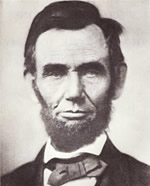by Edward J. Kempf, M.D. Wading River, N.Y.
- Introduction
- Hereditary Determination
- Hypokinetic Constitution
- Lincoln's Face
- Fracture of Skull and Injury of Brain in Boyhood
- Tentative Diagnosis of Nature of Cerebral Injury
- Diplopia and Astigmatism
- Practical Adaptation to Gloomy Eyestrain
- Enigmatical Expression
- Superstitious Interpretation of Diplopia
- Preference for Photographs of Right Side of Face
- Vicious Circle of Organic and Emotional Neuroses
- References
lincolns face
If we examine the full-face photographs of Lincoln and the Volk (1860) life mask of his shaven face, we see that the forehead is narrow and high and bulges slightly in the midline. There is an unusual depression in the forehead of the mask, with a palpable edge, near the midline above the left eye. This deformation indicates the place of fracture of his skull. His head was said by some of his schoolmates, over 50 years later, to have looked small to them (probably relative to his height). Measurement of the Volk life mask between the bases of the tragi of the ears shows a breadth of 15.3 cm., which is somewhat greater than the breadth of the average head. Hence biographical statements that his head was small are erroneous (Fig. 1).
| Figure 1  Life mask (Volk) – 1860 |
In his photographs and masks, the left eye is set higher than the right. His left eyebrow is usually elevated more than the right, to help in keeping the upper lid retracted and the pupil of tile left eye exposed. The tendency of the left eye to turn upward left uncovered more of the white surface of the sclera below the iris, giving a slightly staring effect of that side, in strange disharmony with the appearance of the right eye. In the best frontal photograph (Fig. 2) the left eye is definitely out of focus and turned reflexly slightly upward and possibly outward. This deviation is due to weakening of certain extraocular muscles - possibly the inferior rectus, which is innervated by the third cranial nerve, and/or the superior oblique, which is innervated by the fourth cranial nerve. Lincoln's right eye was used dominantly for general vision and no doubt entirely for reading.*
Figure 2
|
Further examination of the face shows that the left half of the upper lip is somewhat thicker than the right half and less expressive, that is less unvolitionally and volitionally active. Also, the right half of the lower lip protrudes more markedly than the left and is pulled toward the right by the muscles of the cheek. This action characteristically holds the lower lip and facial muscles slightly toward the right. The right side of the chin is also slightly larger than the left, indicating stronger muscle tonus and development from more active use. The right nasofacial crease, previously described, runs somewhat farther from the midline than the left, and the tip of the nose crooks significantly toward the right.* These muscles are supplied by the seventh, or facial, nerve. Although his larynx was large, he had a rasping, high-pitched voice, which grew shrill and squeaky upon emotional excitement, indicating some increase in muscle tonus of the vocal cords or the pharyngeal muscles, under control of the 10th cranial (vagus) nucleus.
Further examination of the life mask, especially measurement for corresponding right and left points from the midline, shows marked differences in the growth of the bones. Although such differences may be genetic or developmental in relation to loss of teeth or defective use from other causes, and cannot be taken as definitely indicative of the effects of an injury of the brain in youth, like the differences in tonic contraction of the ocular and facial muscles, they should be considered and functionally correlated. His cheekbones were unusually high and prominent. The right was larger than the left, and the right orbital ridge and lower jaw were more heavily developed than the left, giving the whole face a decided morphological curve toward the right.*
This deformation becomes distinctly visible when the full-face photograph is turned upside down. When the Volk mask is turned upside down, the larger size of the face, the greater prominence of its lip, chin, and lower jaw, and the greater depression of the face under the cheekbone on the right side are striking*.
*Dr. Frechette's emphasis
next -->

